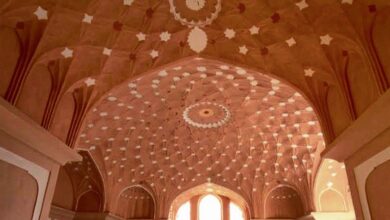The UPShot | Is BJP’s Temple Run Included in the 2024 Blueprint, Stretching from Kashi Vishwanath to Ram Janmabhoomi Corridors?
The well-known pilgrimage sites in Uttar Pradesh are about to change. The Yogi Adityanath administration is building or proposing to build temple corridors in Ayodhya, Mirzapur, Mathura, and Bareilly, while the Kashi Vishwanath Corridor in Varanasi is drawing attention. As a result, the state is rapidly aiming to become the center of religious tourism.

While the BJP’s initiative to renovate UP’s holy sites for over Rs 2,200 crore may excite devotees, opposition parties have taken exception, calling the BJP’s “temple run” a part of its redesigned campaign plan to win over Hindu votes. Meanwhile, political observers predicted that the action would help the party in the next Lok Sabha elections in 2024.
VISHWANATH CORRIDOR IN KASHI
Varanasi, one of the oldest pilgrimage centers in Uttar Pradesh and Prime Minister Narendra Modi’s parliamentary seat, was the first to have the massive Kashi Vishwanath Corridor built. PM Modi laid the project’s foundation in 2019 and gave it his official opening on December 13, 2021, at an estimated cost of roughly Rs 900 crore. The renovation has increased the temple’s surrounding area from 3,000 to 5 lakh square feet, providing space for almost 75,000 pilgrims.
AYODHYA’S PROPOSED RAM JANMABHOOMI CORRIDOR
The UP government suggested building the Ram Janmabhoomi corridor in Ayodhya in August 2021; the project is expected to cost around Rs 800 crore. The plan is to transform Ayodhya’s Bhraman Path to link the Ram Temple and River Saryu. The project is designed to resemble a corridor that runs parallel to the Ganga and links it to Varanasi’s Kashi Vishwanath corridor.
The Bhraman Path will go to Ram Mandir via Rajgath and Ram Ki Paidi. Devotees would be able to use this section of the road to proceed straight to Ram Mandir after having a dip in the Saryu, a UP government official said. By 2024, the corridor should be completed.
VRINDAVAN’S BANKE BIHARI CORRIDOR
The most recent of many temple routes on which construction has started is the Banke Bihari Corridor in Vrindavan, Uttar Pradesh.
Citing Articles 25 and 26 of the Constitution, the Allahabad High Court on November 20 of this year authorized the UP government’s request for the Vrindavan (Mathura) Banke Bihari Temple Corridor. Citing religious, social, historical, and cultural values, the court ordered the clearance of encroachments around the temple and emphasized the public interest in temple administration. It did, however, order the government to utilize its own cash instead of taking Rs 262.50 crore out of the deity’s bank account to build the corridor.
The ruling was made during a public interest lawsuit against Banke Bihari Temple crowd control and pilgrim safety that was being heard by the court. The court recognized problems with temple administration as well as challenges brought on by disagreements amongst Sevayats.
The Banke Bihari Corridor, which is expected to be one of the largest in Uttar Pradesh, would be constructed following the design of the Kashi Vishwanath Corridor in Varanasi, according to district administration officials. “It will be a blend of tradition and modern, where the core area of the temple would remain undisturbed,” authorities said while revealing the layout.
When completed, the corridor would not only strengthen the local economy but also aid in crowd control. The project, which is estimated to cost Rs 262 crore, would provide ample space for devotees, according to the planned layout. The corridor can hold nearly 10,000 devotees at a time, according to authorities, compared to its current capacity of around 800. The “transformation” of the congested streets leading to the temple is also envisaged.
VERY SOON VINDHYACHAL CORRIDOR
Additionally being built is the Vindhyachal Corridor in Mirzapur, Uttar Pradesh. According to a government spokesman, it is being constructed at an estimated cost of Rs 224 crore around the Vindhyachal Temple to help pilgrims. Pink Ahraura stones, skillfully carved by Jaipur craftsmen, are being used to construct the corridor. The corridor’s formal opening is scheduled for this year.
Yogi Adityanath, the chief minister, dreamed up the Maa Vindhyavasini corridor, which would beautify the Maa Vindhyavasini Temple, provide a 50-foot-wide place for “parikrama,” and provide pilgrims with first-rate amenities.
Maa Vindhyavasini Temple will be viewable from the Ganga side after the corridor is built. Following the Kashi Vishwanath Corridor, the Vindhyachal project will be the second corridor in eastern Uttar Pradesh. Additionally, a corridor in Bareilly has been planned by the UP government.
“BJP’S NEW STRATEGY INCLUDES CORRIDORS”
Denouncing it as an effort to win over Hindu votes, The chairman of Bhimrao Ambedkar University’s political science department, Shashikant Pandey, stated: “BJP is focusing on religious places because larger Hindu sentiments are attached to it.” Their mission of Hindu/cultural nationalism is mostly connected to the remodeling and construction of corridors. In addition to its developmental programs, particularly its beneficiary schemes, the BJP is attempting to bridge the divide by reaching out to its core supporters and erasing divisions based on caste, etc.
Pandey continued, saying that the BJP will benefit from the corridors’ development by drawing attention away from problems like the caste-based census. Additionally, the party is aware of the powerful emotional pull that religion has, as shown by the crowds that gather whenever such passageways appear. Since the BJP can take credit for this, a mix of sensitive topics and developmental projects is being exploited to galvanize popular support.







